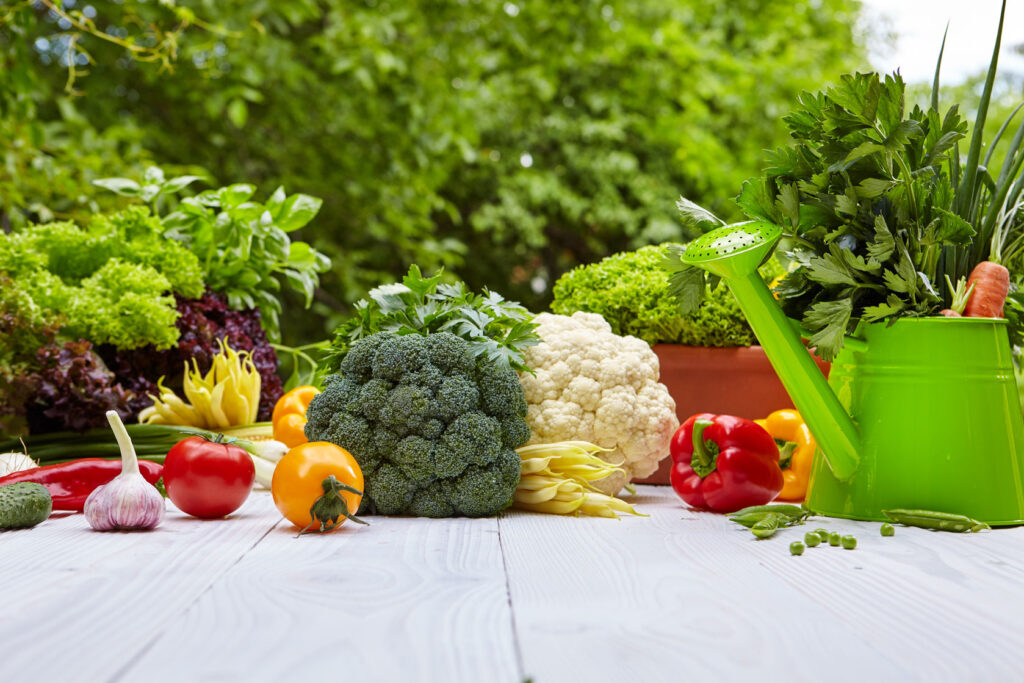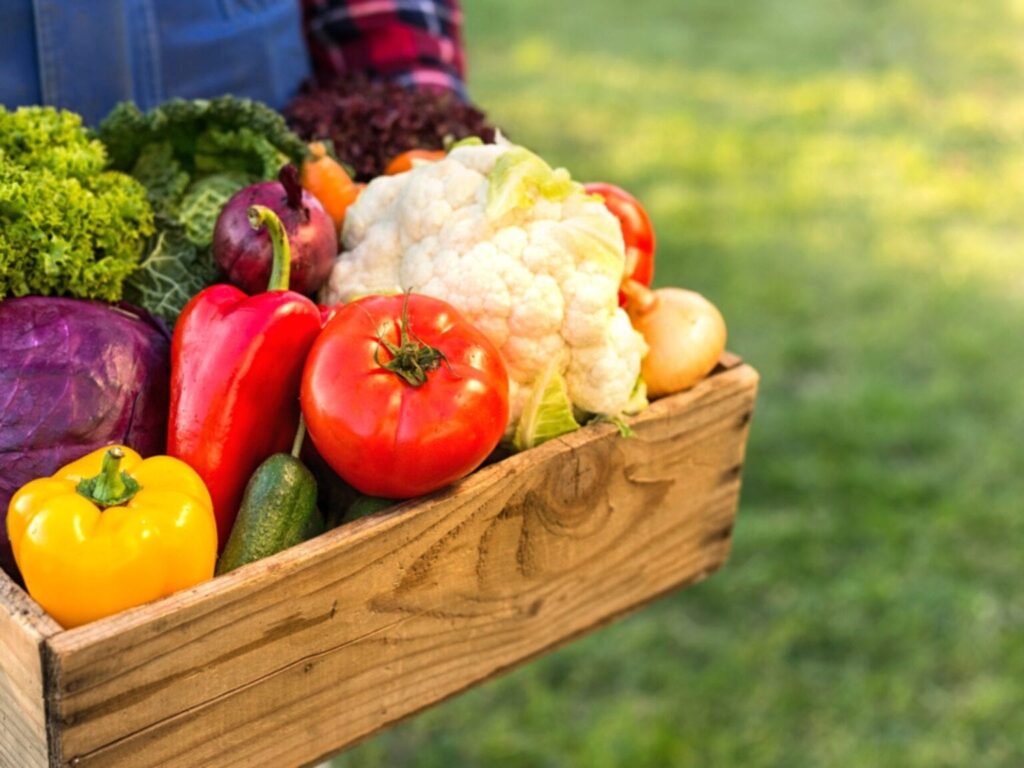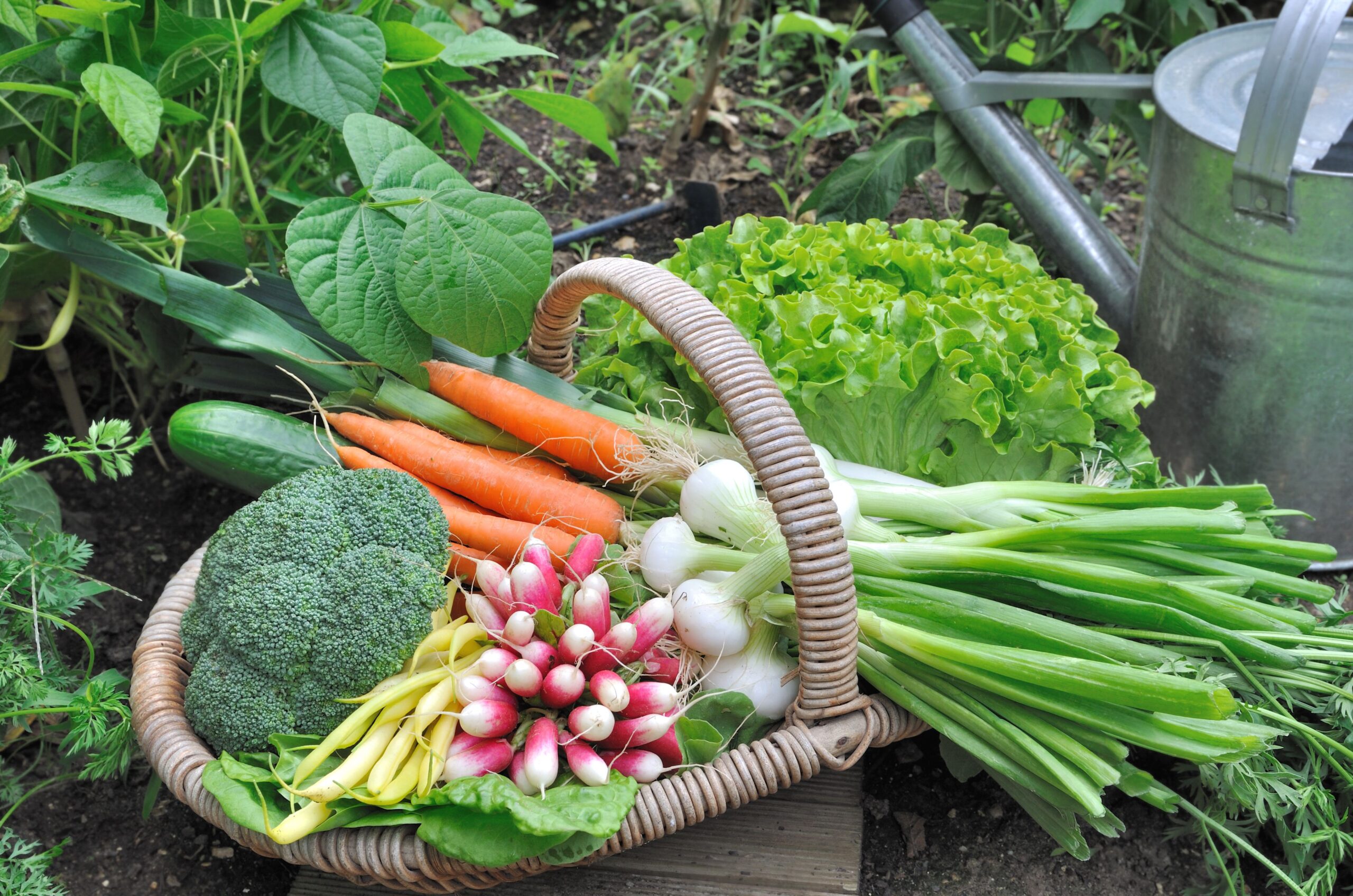Vegetable gardening is a rewarding and fulfilling endeavor that allows individuals to connect with the earth, enjoy the fruits of their labor, and savor the taste of fresh, homegrown produce. Whether you have a sprawling backyard or just a few pots on a balcony, vegetable gardening can be tailored to fit various spaces and skill levels.
You might wonder, “Why garden?” Would you like to savor the greatest fruit and veggies you’ve ever eaten? The sweet, juicy tastes and vivid textures of food straight from the garden will wow you if you’ve never experienced them. Nothing compares to fresh vegetables at all, especially if you cultivate them yourself, which is possible!
Though it can be intimidating at first, gardening is a really fulfilling pastime. We’ll go over the fundamentals of vegetable gardening and planning on this page, including how to choose which veggies to produce, how to design the ideal garden size, and where to put your garden.
Choosing a location, designing the garden, preparing the soil, selecting the seeds and plants, planting a crop, and caring for the plants until they are ready to be harvested are all part of vegetable gardening. Fresh food that can be eaten, shared, or sold is the end product.
Anyone can cultivate a vegetable garden if they are prepared to put in a few hours a day to tend to the plants. Money, time, or skill are not necessary in large quantities, though they would all be beneficial. Every year, with perseverance and effort, your talents will get better. If the initial try doesn’t turn out to be a tremendous success, don’t give up.
Vegetables require some space to grow, but not necessarily acres. Vegetable gardens don’t always have to be in planting beds or on the ground. You can grow a lot of vegetables in pots.
You could produce enough lettuce for a salad in a 12-inch container on the back porch, for instance. You have a decent start on a tasty salad with a few radishes and carrots added for sweetness and spice, each grown in 12-inch containers.
But more is needed for success than just a spot to produce the veggies. They require soil, fertilizer, sunlight, water, and air. The real excitement of gardening is in conquering unforeseen challenges and finishing the season with a bountiful crop, which you’ll discover as you go. You truly get to enjoy the results of your hard work!
This comprehensive guide explores the various aspects of vegetable gardening, from planning and soil preparation to planting, nurturing, and harvesting a bountiful crop.

Planning Your Vegetable Garden
Embarking on a vegetable gardening journey requires thoughtful planning to ensure a successful and bountiful harvest. From choosing the optimal location to designing an efficient layout, the planning phase lays the foundation for a thriving vegetable garden.
Selecting the Right Location
The success of your vegetable garden hinges on the amount of sunlight your plants receive. Most vegetables thrive in full sun, requiring at least 6-8 hours of direct sunlight daily. Begin by observing your outdoor space throughout the day to identify the sunniest spots. Ideally, choose a location with a southern or western exposure to maximize sunlight exposure.
Understanding Soil Composition
Conduct a soil test to comprehend the composition of your garden soil. Knowing the pH and nutrient levels allows you to tailor the soil to the specific needs of the vegetables you plan to grow. Amend the soil with organic matter, such as compost or well-rotted manure, to enhance its structure, drainage, and fertility. Well-draining soil is essential to prevent waterlogging, ensuring healthy root development.
Designing Your Garden Layout
Creating an efficient garden layout involves strategic thinking about plant placement, spacing, and accessibility. Consider factors like the mature size of plants, companion planting principles, and the ease of maintenance. Raised beds offer a well-defined structure, improved drainage, and an organized layout, making them a popular choice for vegetable gardens.
Choosing the Right Vegetables
Consider Your Climate Zone
Understanding your USDA hardiness zone is crucial for selecting vegetables that thrive in your specific climate. Different zones have varying temperatures and weather patterns, and choosing vegetables adapted to your zone increases the likelihood of a successful harvest. Many seed packets and plant labels provide information on the recommended hardiness zones for optimal growth.
Grow What You Love to Eat
A successful vegetable garden is not only about the quantity of produce but also about the quality and satisfaction it brings. Select vegetables that you and your family enjoy eating. Whether it’s the sweetness of homegrown tomatoes, the crispness of fresh lettuce, or the zing of homegrown peppers, cultivating what you love enhances the overall gardening experience.
Seasonal Planning
Plan your garden to include a variety of vegetables with different maturation times. This could involve staggered planting or selecting vegetables that mature at different rates. Seasonal planning ensures a continuous harvest throughout the growing season, providing you with a diverse array of fresh produce.
Implementing Your Plan
Preparing the Ground
Once you’ve chosen the location and planned your garden layout, it’s time to prepare the ground. Remove any weeds or debris and, if necessary, level the ground. If you’re opting for raised beds, assemble and position them according to your planned layout.
Soil Amendments
Before planting, incorporate soil amendments based on the results of your soil test. Add organic matter such as compost, aged manure, or well-rotted leaves to enhance the soil’s fertility. Well-nourished soil is the cornerstone of a productive vegetable garden.
Planting with Precision
When planting, adhere to the spacing guidelines for each type of vegetable. Proper spacing ensures that each plant receives adequate sunlight, nutrients, and airflow. Crowded plants are more prone to diseases and compete for resources, potentially stunting their growth.
Mulching Magic
Apply a layer of organic mulch around your plants. Mulch acts as a protective barrier, suppressing weeds, conserving soil moisture, and regulating soil temperature. It also contributes to a tidy appearance, creating a visually appealing garden.
Watering Wisdom
Maintain consistent watering practices to keep your vegetable garden healthy. Vegetables generally require about 1-1.5 inches of water per week. Water deeply to encourage deep root growth, but avoid waterlogging, which can lead to root diseases.
Planting and Nurturing Your Vegetable Garden
Once the groundwork of planning is laid, it’s time to dive into the heart of vegetable gardening, planting and nurturing your garden. This phase transforms your vision into reality, as you sow seeds, transplant seedlings, and embark on the journey of fostering life from the soil. Understanding the nuances of planting and providing ongoing care is crucial for the success of your vegetable garden.
Starting from Seeds
Selecting high-quality seeds is the initial step in starting your vegetable garden. Opt for seeds from reputable sources or consider seed swaps with fellow gardeners. Check for the expiration date on seed packets to ensure viability.
Some vegetables, like tomatoes, peppers, and broccoli, benefit from an early start indoors. Use seed trays or small pots filled with a seed-starting mix. Provide adequate light, warmth, and moisture to encourage germination.
Once your seedlings have developed a few true leaves, it’s time to transplant them into larger containers or directly into the garden. Harden off the seedlings by gradually exposing them to outdoor conditions before transplanting to reduce transplant shock.

Direct Sowing
Direct sowing involves planting seeds directly into the garden soil. Consider the recommended planting times for each vegetable, usually indicated on seed packets. Some vegetables, like beans and radishes, are well-suited for direct sowing.
Prepare the soil by removing any weeds and loosening the top layer. Follow the guidelines on seed packets regarding planting depth and spacing. Water the area before and after sowing to ensure good seed-to-soil contact.
Transplanting Seedlings
Transplant seedlings into the garden bed after the last frost date in your region. Consult local gardening resources or extension offices for accurate frost date information.
Dig holes in the garden bed that are large enough to accommodate the root system of each seedling. Space the holes according to the recommended spacing for the specific vegetables.
Water the transplants immediately after planting to help settle the soil around the roots. Provide ongoing water as needed to support the establishment of the transplants in their new environment.
Mulching for Moisture Retention and Weed Suppression
Mulching is a valuable practice in vegetable gardening. Apply a layer of organic mulch, such as straw or wood chips, around your plants. Mulch helps retain soil moisture, suppresses weed growth, and regulates soil temperature.
Ensure that the mulch is applied evenly around the plants, leaving a gap around the stem to prevent rot. Replenish mulch as needed throughout the growing season.
Watering
Consistent watering is crucial for the health of your vegetable garden. Water deeply and at the base of the plants to encourage deep root growth. Avoid overhead watering to reduce the risk of diseases.
Consider using drip irrigation or soaker hoses for efficient water delivery. These methods minimize water wastage and keep foliage dry, reducing the likelihood of fungal diseases.
Fertilizing
Regularly test the soil to assess nutrient levels. Adjust your fertilization routine based on the specific needs of your vegetables. Phosphorus-rich fertilizers are particularly beneficial for flowering and fruiting plants.
Consider using organic fertilizers such as compost, well-rotted manure, or organic granular fertilizers. These options provide a slow release of nutrients and contribute to the overall health of the soil.
Companion Planting
Implement companion planting strategies to optimize the use of garden space. For example, planting tall crops like corn alongside climbing beans allows for efficient use of vertical space.
Companion planting can also help control pests. Certain plants, when grown together, emit natural compounds that repel or confuse pests. Marigolds, for instance, can deter nematodes, while basil can help protect tomatoes from certain pests.
Vertical Gardening
Embrace vertical gardening to maximize space and sunlight utilization. Install trellises or stakes to support vining plants such as tomatoes, cucumbers, and peas.
Vertical gardening not only saves space but also enhances air circulation, reducing the risk of fungal diseases. Ensure that your supports are sturdy enough to bear the weight of the plants as they grow.
Dealing with Common Challenges in Vegetable Gardening
While the joy of vegetable gardening is immense, it often comes with its share of challenges. Pests, diseases, and unexpected weather conditions can pose threats to your carefully nurtured garden. Effectively dealing with these challenges is crucial to ensure a thriving and productive vegetable patch.
Identifying and Managing Pests
Conduct regular inspections of your plants to identify signs of pests. Look for chewed leaves, discolored spots, or the presence of insects. Early detection allows for prompt intervention, preventing pest infestations from escalating.
Encourage natural predators such as ladybugs, lacewings, and predatory beetles. These beneficial insects help control pest populations without the need for chemical interventions. Avoid broad-spectrum pesticides that can harm both pests and beneficial insects.
Utilize organic pest control methods such as neem oil, insecticidal soaps, or garlic sprays. These options are effective against many common garden pests while minimizing harm to the environment.
Disease Prevention
Practice good garden hygiene by removing diseased plants promptly. Dispose of infected plant material in the trash rather than composting to prevent the spread of diseases.
Ensure proper spacing between plants to promote air circulation. Adequate airflow helps reduce the humidity around plants, minimizing the conditions favorable for fungal diseases like powdery mildew.
Choose vegetable varieties that are resistant to common diseases prevalent in your region. Resistant plants are less susceptible to infections, providing an additional layer of defense.
Harvesting
The moment you’ve been eagerly anticipating arrives when it’s time to harvest the fruits of your labor. Proper harvesting ensures peak flavor, nutritional content, and continuous productivity from your vegetable garden.
Harvesting at the Right Time
Harvest each vegetable at its peak of maturity. For example, tomatoes should be picked when they are fully colored and firm, while lettuce is best harvested before it bolts or becomes bitter.
Engage in regular harvesting, especially with crops like beans, zucchini, and cucumbers. Frequent picking encourages the plant to produce more, extending the harvest period.
Use sharp and clean garden shears or scissors to harvest your vegetables. Clean cuts minimize damage to the plant and reduce the risk of introducing diseases.
Continuous Harvest
Extend your harvest by practicing successive planting. After harvesting a crop, replant the same space with a quick-growing vegetable for continuous production.
Rotate crops within your garden beds each season. Crop rotation helps prevent soil-borne diseases and optimizes nutrient availability by changing the location of plants within the raised bed each growing season.
Seasonal Maintenance and Succession Planting
As each growing season comes to an end, and your garden transitions, a series of maintenance tasks become crucial to ensure the long-term vitality of your vegetable garden.
Preparing for the Next Season
At the end of the growing season, engage in a thorough cleanup. Remove spent plants, fallen leaves, and any garden debris. Clearing the garden beds creates a clean slate for the next season.
Replenish the soil with well-composted organic matter. Compost adds essential nutrients, improves soil structure, and supports the development of beneficial soil microorganisms.
Succession Planting
Succession planting involves replacing harvested crops with new ones for continuous production. Understanding the planting windows for different vegetables ensures a well-utilized and productive garden space.
Plan succession plantings based on the temperature preferences of crops. Cool-season crops like lettuce and spinach can follow warm-season crops like tomatoes and peppers, maximizing the use of your garden beds.
Winter Garden Considerations
Explore the possibilities of a winter garden by planting cold-tolerant vegetables such as kale, carrots, and Brussels sprouts. These hardy crops can withstand cooler temperatures and provide fresh harvests during the winter months.
Implement protective measures such as row covers or cold frames to shield winter crops from frost. These structures create a microclimate that extends the growing season.
Vegetable Gardening FAQs
How to build a vegetable garden?
- Deciding on the ideal site.
- Estimating the size of the garden you will require.
- Take out the grass.
- Putting a fence around your garden.
- Getting the soil ready.
- Put Mulch on It.
- Sowing your seeds or seedlings for vegetables.
- Take good care of your veggie garden.
How do I choose the right vegetables for my garden based on my climate?
Consider your USDA hardiness zone to determine which vegetables are best suited for your region. This ensures that you plant varieties capable of withstanding your local climate.
What is the best time to plant vegetables?
That’s two to four weeks ahead of the last spring frost in most places. It is recommended to wait until the soil dries out a bit before planting in damp soil that is still very wet from snow or spring rains to prevent your seeds or transplants from rotting.
Conclusion
Vegetable gardening is not just about producing food; it’s a journey that connects you with nature, imparts valuable skills, and brings a sense of fulfillment.
By understanding the fundamentals of planning, planting, nurturing, and harvesting, you can create a vegetable garden that not only provides fresh, flavorful produce but also becomes a source of joy and well-being in your daily life. Whether you’re a seasoned gardener or just starting, the journey of vegetable gardening is a delightful and enriching experience.


